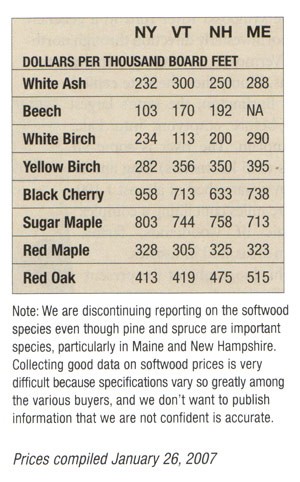The prices reported here are those that log buyers—mostly sawmills and wholesalers—are paying for logs.
Because these are prices paid for delivered wood, landowners need to adjust the prices down to get an idea of what they might receive from the logger for their trees. Please read the section below for a discussion of the factors that affect the price paid to landowners.
The prices are for one specific grade of logs within the species: a log of average quality, not a prime sawlog and not a poor one. For hardwoods, it’s a log at least 8 feet long with three clear faces and a minimum 12-inch top diameter. For white pine, we’ve taken an average of the middle grades (in very general terms, it’s for a minimum 10-inch top 12 to 16 feet long with knots smaller than 6 inches, but larger than 1 inch.) For spruce/fir, it’s for a minimum 5-inch top and at least 10 feel long. For hemlock, it’s a minimum 8-inch top and at least 12 feet long.
Sawlogs are scaled with the International 1/4 inch rule.
Factors affecting price paid to landowners
These prices are for trees that have been felled, limbed, brought to a landing, made into logs, and delivered to a mill. In some cases, buyers pay for logs on the landing and build trucking costs into the price. Trucking logs to the mill typically costs from $45 to $75/MBF, but can run higher for long hauls.
The cost of logging varies greatly. The least expensive logging job is on a lot that has a high volume of large-diameter, high-quality trees marked for cutting, has a good internal road system over flat, dry ground with a central landing and short skidding distance. Higher logging costs result when one or more of the above is missing. The underlying principles are simple: a logger needs to make a certain amount of money per hour and the more difficult it is to operate, the less he can pay for the wood; low-value wood costs the same as high-value wood to remove and there won’t be much left to pay stumpage if the costs are hight and the value is low. The cost for cutting and yarding normally ranges from $100/MBF to $250/MBF, but in some circumstances it can reach more than $500/MBF.
Negotiating a fair price requires an understanding of markets and job conditions. It’s recommended that landowners without this knowledge use a forester for an agent. A forester’s fee will add to the cost, but studies show that their representation results in higher payment for the timber.
These data are compiled from interviews with suppliers and buyers, and from the most recent print and on-line versions of the edition of Sawlog Bulletin and used by permission. Please note that many of these prices were reported three months prior to our publication date, and current prices could be higher or lower.


